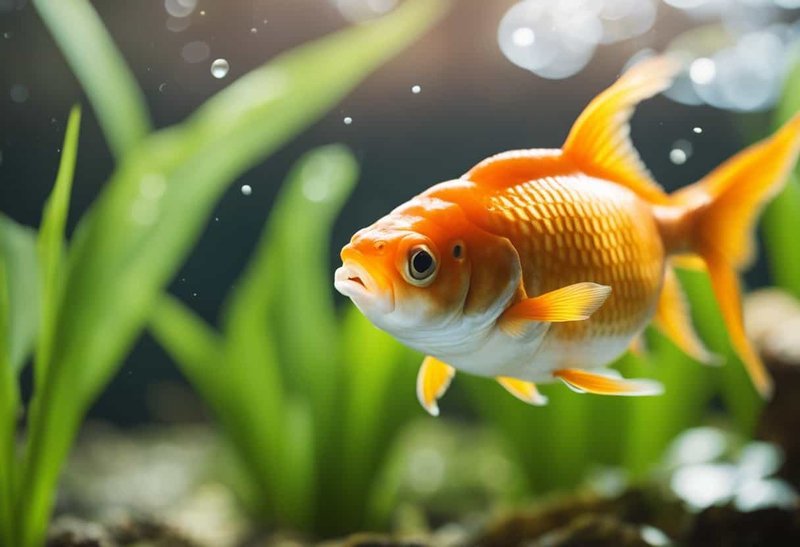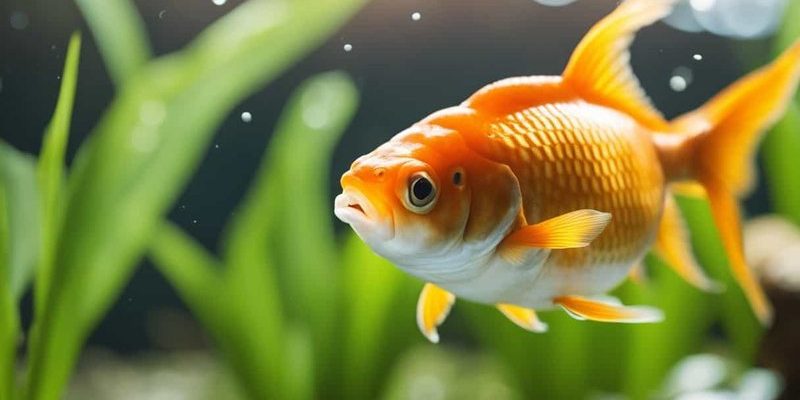
Think of it like being a detective. Each little wiggle, each bubble they blow, and every time they dart around the tank can give you clues about how they’re feeling. Just like a dog might wag its tail when excited or bark when it wants attention, your goldfish has its own unique way of expressing itself. So, let’s dive into the fascinating world of goldfish behavior and learn what to watch for as you care for your aquatic companion.
Understanding Goldfish Behavior
Goldfish are known for their bright colors and gentle movements, but there’s a lot happening beneath the surface of their calm exteriors. Understanding goldfish behavior can really help you gauge how they’re doing. Just like people, fish have emotions and moods that can change based on their environment, health, and social interactions.
One key thing to remember is that goldfish are social creatures. They often enjoy interacting with their tank mates. If you notice your fish swimming together or mirroring each other’s movements, they’re likely feeling comfortable and happy in their space. On the flip side, if they start hiding behind plants or staying at the bottom of the tank, it might be a sign that something’s off—like stress or illness.
Here’s the thing: a healthy goldfish will show curiosity. They’ll swim towards you when you approach the tank, eager for food or just to see what’s going on. If they suddenly become lethargic or stop showing interest in their surroundings, it could be time to investigate further.
Common Goldfish Behaviors and Their Meanings
Goldfish can display a variety of behaviors, each with its own meaning. Let’s break down some of the most common ones so you can better understand your aquatic friend.
1. Swimming in Circles: If you see your goldfish swimming in circles, it can indicate excitement, but it might also be a sign of stress or an illness called “twitching.” It’s essential to pay attention to other symptoms, like rapid gill movement or changes in color, to determine if something’s wrong.
2. Bubbles and Blowing Bubbles: You might catch your goldfish blowing bubbles at the surface. This behavior can be perfectly normal as they’re just gulping air or getting rid of excess gas. However, if they’re doing it constantly, it might indicate issues with water quality or oxygen levels.
3. Hiding: If your goldfish suddenly takes to hiding, whether behind plants or ornaments, it could mean they’re feeling stressed. This could be due to a change in the tank environment, new tank mates, or even loud noises in the room. Check if anything has changed in their habitat that might be bothering them.
4. Flashing: This is when a goldfish rubs against objects in the tank. It could mean they’re trying to get rid of something irritating their skin. This behavior is often a warning sign that you should check for parasites or other skin issues.
Each of these behaviors tells a unique story about your goldfish’s feelings and health. By observing their actions closely, you can gain insight into their world.
How to Create a Happy Environment for Your Goldfish
If you want to keep your goldfish healthy and happy, creating the right environment is key. Goldfish are quite adaptable, but they thrive in specific conditions. Here’s how you can set the stage for success.
First, tank size matters. A common mistake is keeping goldfish in small bowls, which can lead to stress and unhealthy living conditions. Ideally, a single goldfish should have at least a 20-gallon tank. The more space they have, the more comfortably they can swim and explore.
Next, consider water conditions. Goldfish prefer cool water, ideally between 65°F and 75°F. You should monitor the pH level as well, keeping it between 6.0 and 8.4. Regular water changes (around 20% weekly) can help maintain these levels and keep your goldfish swimming happily.
Lastly, don’t forget about decor! Adding plants, rocks, and hiding spots can provide enrichment and reduce stress. Goldfish love to explore and play, so creating a stimulating environment will keep them engaged and healthy.
Recognizing Signs of Stress or Illness
No one wants to see their goldfish in distress. Recognizing the signs of stress or illness can help you act quickly to address any issues. Here are some red flags to look out for.
One of the first signs of stress is erratic swimming. If your goldfish is darting around the tank or swimming in an uncoordinated manner, it could signal that they’re not feeling well. Check the water conditions immediately, as poor water quality is often the root cause of stress in fish.
Another major indicator is loss of appetite. If your goldfish suddenly stops eating, it’s usually a cause for concern. They might be sick, or perhaps the food you’re offering doesn’t appeal to them. Try offering different types of fish food to see if they show any interest.
Lastly, look for changes in appearance, such as faded colors, frayed fins, or spots on their body. These symptoms could indicate various health issues like disease or parasites. If you notice these changes, it’s essential to consult with a vet experienced in fish care.
Interacting with Your Goldfish
Building a bond with your goldfish can be a rewarding experience. Believe it or not, your fish can recognize you! Over time, they might even learn to associate your presence with feeding. Here’s how you can interact with your goldfish effectively.
Start by spending time near the tank, and watch how your goldfish react. If they come closer and swim around you, they’re likely comfortable with your presence. You can reinforce this behavior by feeding them small amounts of food regularly when you’re around. They’ll start to associate you with something positive—like tasty treats!
Another fun activity is using a stick or your finger to gently tap the tank’s side. Your goldfish may come to investigate. Just be careful not to startle them too much, as some fish might interpret quick movements as threats.
Keep in mind that goldfish can get bored. To keep things interesting, consider rotating toys or adding new decorations. Engaging your goldfish helps them stay active and can reduce stress in their environment.
Feeding Your Goldfish: What to Know
Feeding your goldfish the right diet is crucial for their health and happiness. They rely on you to provide them with the necessary nutrients to thrive. Here’s a little guide to help you navigate their feeding habits.
Goldfish are omnivores, so they enjoy a variety of foods. High-quality flakes or pellets specifically designed for goldfish are excellent staples. You can also introduce occasional treats like blanched vegetables (e.g., peas or zucchini) to add some variety to their diet. Just make sure to chop them into tiny pieces so your fish can easily eat them.
When feeding, aim for smaller portions that they can finish in a few minutes. Overfeeding can lead to water quality issues and health problems. Honestly, it’s better to err on the side of underfeeding than overfeeding. You can always provide a bit more if they seem hungry.
Lastly, always remove any uneaten food after a few minutes to prevent it from decomposing and polluting the water. By keeping a close eye on your goldfish’s diet and feeding habits, you can contribute to their overall well-being.
Taking care of a goldfish can be a truly rewarding experience. By understanding their behaviors, creating a suitable environment, and ensuring proper nutrition, you’ll be well on your way to raising a happy and healthy finned friend. It’s all about being observant and responsive to their needs, just like you would with any pet.
Remember, every little wiggle or bubble from your goldfish can give you valuable insight into their health and mood. So, the next time you watch your goldfish, pay attention. You might just discover something new about your aquatic companion that enhances your bond. Caring for them isn’t just about keeping water clean; it’s about nurturing a little life that brings joy to your home.

